Three-Dimensional Resource Allocation in D2D-Based V2V Communication
Abstract
:1. Introduction
- Power allocation for the three types of users—cellular user equipment (CUE), V2V, V2I—keeping in mind the constraints and capacity calculation using 3-dimensional matching in graphs.
- A hypergraph coloring-based RB allocation using an adjacency matrix.
2. Network Architecture and System Model
2.1. Network Architecture
2.2. Requirements for Different User Equipment (UE)
2.3. System & Channel Model
3. Matching and Resource Block Allocation Scheme
3.1. Optimal Power Allocation
| Algorithm 1 Newton Method |
| 1. Initialize tol = 1e−7 (error) 2. Initialize N_max = 1e7 (maximum number of iterations) 3. it = 1 (iteration number) 4. f=Var.*g_l/(sinr_min.*g_kl)*(((Var.*g_l)/(Pj*sinr_min*g_jl+Var.*g_l)/(1-p0))-1) (f=function) 5. Pl_0=sinr_min*(1-p0)*Pj*g_jl/(g_l*p0) 6. Var = Pl_0 (initial condition) 7. while (it<=N_max) 8. yy = Var (Var = temporary variable) 9. Var = yy –(f(Var)/df(Var)) 10. if (abs(Var-Pl_0)/abs(Var)) < tol 11. Pl_max = Var 12. Pl_opt = Pl_max 13. Pk_opt = Pk_max 14. Pj_opt = (sinr_th_cue*((Pk_opt*g_kj)+(Pl_opt*g_lj))/g_jB) 15. break 16. end 17. it=it+1 18. end |
3.2. Hypergraph-Based Matching and RB Allocation
3.2.1. Matching Using Hypergraphs
3.2.2. RB Allocation Using Graph Coloring
4. Simulations and Results
4.1. Vehicular Speed vs. Capacity at Different CUE SINRs
4.2. Vehicular Speed vs. Capacity at different Number of Users
4.2.1. CUE Users
4.2.2. V2V Users
4.3. Transmit Power of V2I vs. Capacity
5. Discussion and Future Work
6. Conclusions
Author Contributions
Funding
Conflicts of Interest
Appendix A
References
- Ahmad, M.; Azam, M.; Naeem, M.; Iqbal, M.; Anpalagan, A.; Haneef, M. Resource management in D2D communication: An optimization perspective. J. Netw. Comput. Appl. 2017, 93, 51–75. [Google Scholar] [CrossRef]
- Huang, Y.; Nasir, A.; Durrani, S.; Zhou, X. Mode Selection, Resource Allocation and Power Control for D2D-Enabled Two-Tier Cellular Network. IEEE Trans. Commun. 2016, 64, 3534–3547. [Google Scholar] [CrossRef]
- Zhang, R.; Cheng, X.; Yao, Q.; Wang, C.-X.; Yang, Y.; Jiao, B. Interference Graph-Based Resource-Sharing Schemes for Vehicular Networks. IEEE Trans. Veh. Technol. 2013, 62, 4028–4039. [Google Scholar] [CrossRef] [Green Version]
- Wang, B.; Zhang, R.; Chen, C.; Cheng, X.; Yang, L. Interference Hypergraph-Based Resource Allocation (IHG-RA) for NOMA-Integrated V2X Networks. In Proceedings of the 2018 IEEE Global Communications Conference (GLOBECOM), United Arab Emirates, 9–13 December 2018; pp. 161–170. [Google Scholar]
- Yang, T.; Zhang, R.; Cheng, X.; Yang, L. Graph Coloring Based Resource Sharing (GCRS) Scheme for D2D Communications Underlaying Full-Duplex Cellular Networks. IEEE Trans. Veh. Technol. 2017, 66, 7506–7517. [Google Scholar] [CrossRef]
- Zhang, H.; Song, L.; Han, Z.; Zhang, Y.J. In Hypergraph theory in wireless communication networks; Springer International Publishing: Cham, Switzerland, 2018; Chapter 2; pp. 21–39. [Google Scholar]
- Sun, W.; Strom, E.G.; Brannstrom, F.; Sou, K.C.; Sui, Y. Radio Resource Management for D2D-Based V2V Communication. IEEE Trans. Veh. Technol. 2016, 65, 6636–6650. [Google Scholar] [CrossRef]
- Sun, W.; Ström, E.G.; Brännström, F.; Sui, Y.; Sou, K.C. D2D-based V2V communications with latency and reliability constraints. In Proceedings of the 2014 IEEE Globecom Workshops (GC Wkshps), Austin, TX, USA, 8–12 December 2014. [Google Scholar]
- Mei, J.; Zheng, K.; Zhao, L.; Teng, Y.; Wang, X. A Latency and Reliability Guaranteed Resource Allocation Scheme for LTE V2V Communication Systems. IEEE Trans. Wirel. Commun. 2018, 17, 3850–3860. [Google Scholar] [CrossRef]
- Liang, L.; Li, G.Y.; Xu, W. Resource Allocation for D2D-Enabled Vehicular Communications. IEEE Trans. Commun. 2017, 65, 3186–3197. [Google Scholar] [CrossRef]
- Wei, Q.; Sun, W.; Bai, B.; Wang, L.; Strom, E.G.; Song, M. Resource allocation for V2X communications: A local search based 3D matching approach. In Proceedings of the 2017 IEEE International Conference on Communications (ICC), Paris, France, 21–25 May 2017. [Google Scholar]
- Wang, Y.; Yang, Z.; Pan, Y.; Chen, M. Joint power control and user pairing for ergodic capacity maximization in V2V communications. In Proceedings of the 2017 9th International Conference on Wireless Communications and Signal Processing (WCSP), Nanjing, China, 11–13 October 2017. [Google Scholar]
- Liang, L.; Xie, S.; Li, G.Y.; Ding, Z.; Yu, X. Graph-Based Radio Resource Management for Vehicular Networks. In Proceedings of the 2018 IEEE International Conference on Communications (ICC), Kansas City, MO, USA, 20–24 May 2018. [Google Scholar]
- Li, Z.; Chen, S.; Guo, C. Location-Aware Hypergraph Coloring Based Spectrum Allocation for D2D Communication. In Proceedings of the 2018 15th International Symposium on Wireless Communication Systems (ISWCS), Lisbon, Portugal, 28–31 August 2018. [Google Scholar]
- Liang, L.; Xie, S.; Li, G.Y.; Ding, Z.; Yu, X. Graph-Based Resource Sharing in Vehicular Communication. IEEE Trans. Wirel. Commun. 2018, 17, 4579–4592. [Google Scholar] [CrossRef]
- Liang, L.; Peng, H.; Li, G.Y.; Ding, Z.; Yu, X. Vehicular Communications: A Physical Layer Perspective. IEEE Trans. Wirel. Commun. 2017, 66, 10647–10659. [Google Scholar]
- Sahin, T.; Boban, M. Radio Resource Allocation for Reliable Out-of-Coverage V2V Communications. In Proceedings of the 2018 IEEE 87th Vehicular Technology Conference (VTC Spring), Porto, Portugal, 3–6 June 2018. [Google Scholar]
- Gu, Y.; Saad, W.; Bennis, M.; Debbah, M.; Han, Z. Matching theory for future wireless networks: fundamentals and applications. IEEE Commun. Mag. 2015, 53, 52–59. [Google Scholar] [CrossRef] [Green Version]
- Liang, L.; Ye, H.; Li, G.Y. Towards Intelligent Vehicular Networks: A Machine Learning Framework. IEEE Int. Things J. 2019, 6, 124–135. [Google Scholar] [CrossRef]
- Ye, H.; Li, G.Y. Deep Reinforcement Learning for Resource Allocation in V2V Communications. In Proceedings of the 2018 IEEE International Conference on Communications (ICC), Kansas City, MO, USA, 20–24 May 2018. [Google Scholar]
- Abbas, F.; Fan, P.; Khan, Z. A Novel Low-Latency V2V Resource Allocation Scheme Based on Cellular V2X Communications. IEEE Trans. Intell. Transp. Syst. 2018, 20. [Google Scholar] [CrossRef]
- Yu, N.; Mei, J.; Zhao, L.; Zheng, K.; Zhao, H. Radio resource allocation for D2D-based V2V communications with Lyapunov optimization. In Proceedings of the 2017 IEEE/CIC International Conference on Communications in China (ICCC), Qingdao, China, 22–24 October 2017. [Google Scholar]
- Sun, W.; Yuan, D.; Strom, E.G.; Brannstrom, F. Cluster-Based Radio Resource Management for D2D-Supported Safety-Critical V2X Communications. IEEE Trans. Wirel. Commun. 2016, 4, 2756–2769. [Google Scholar] [CrossRef]
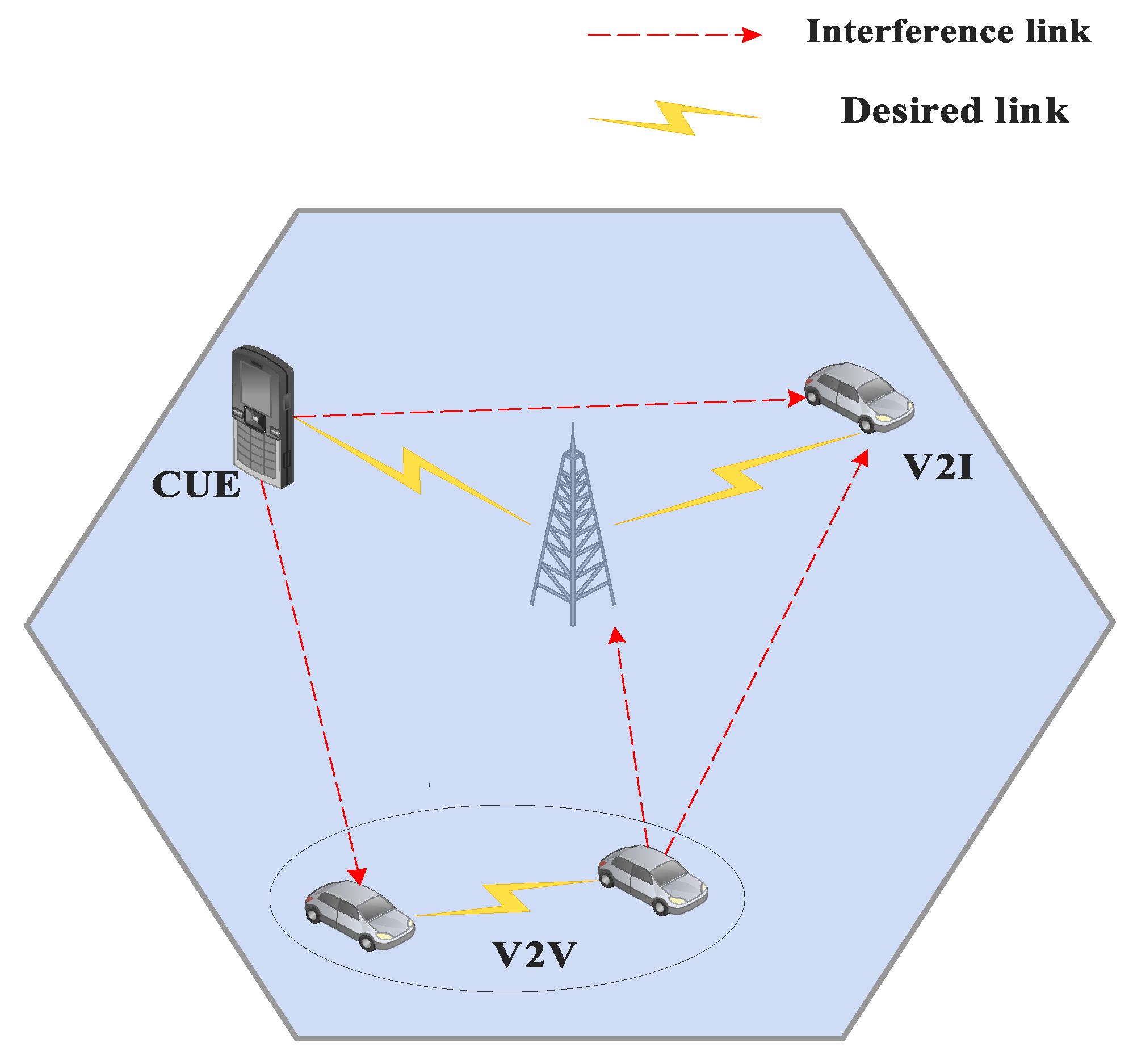
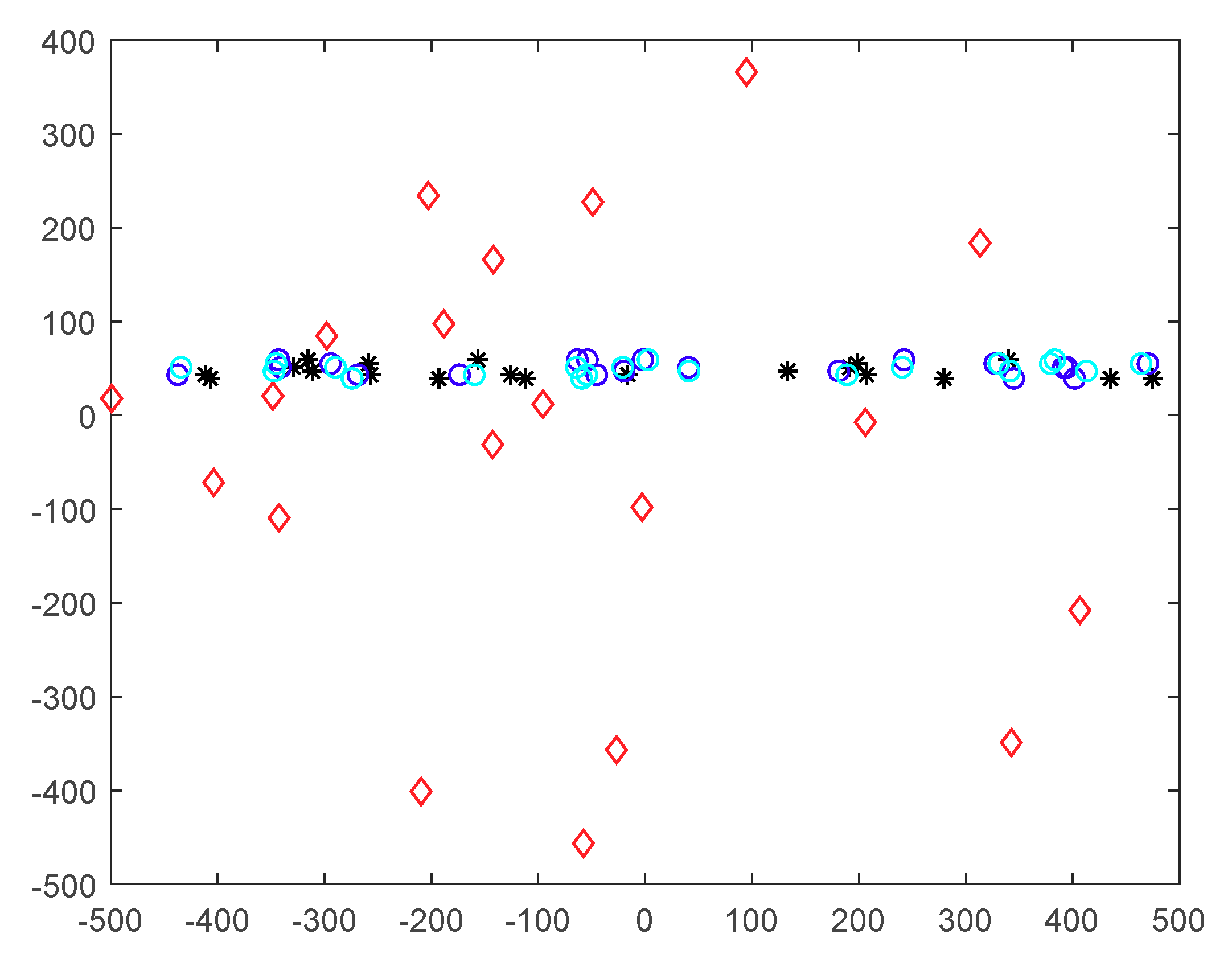
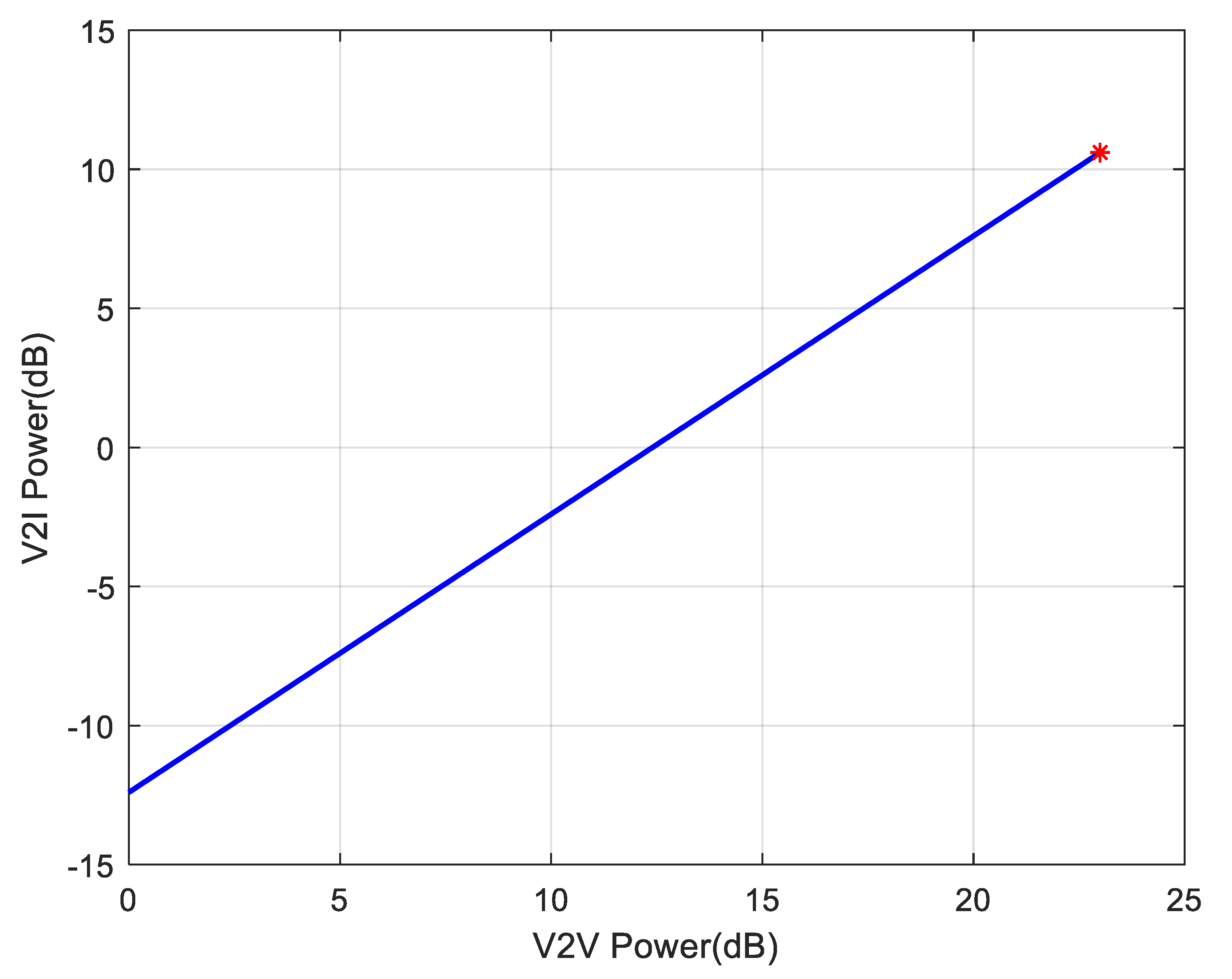
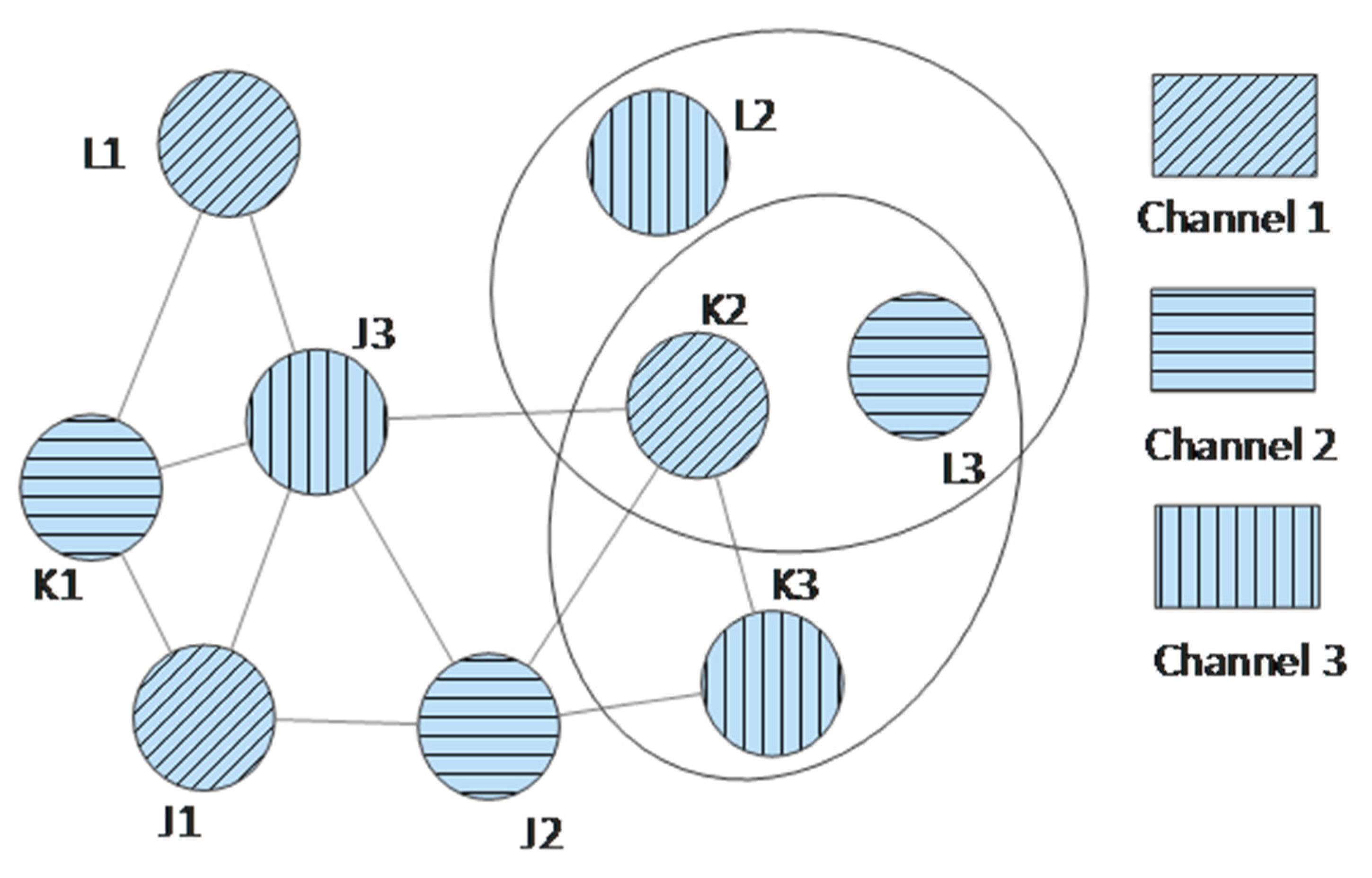

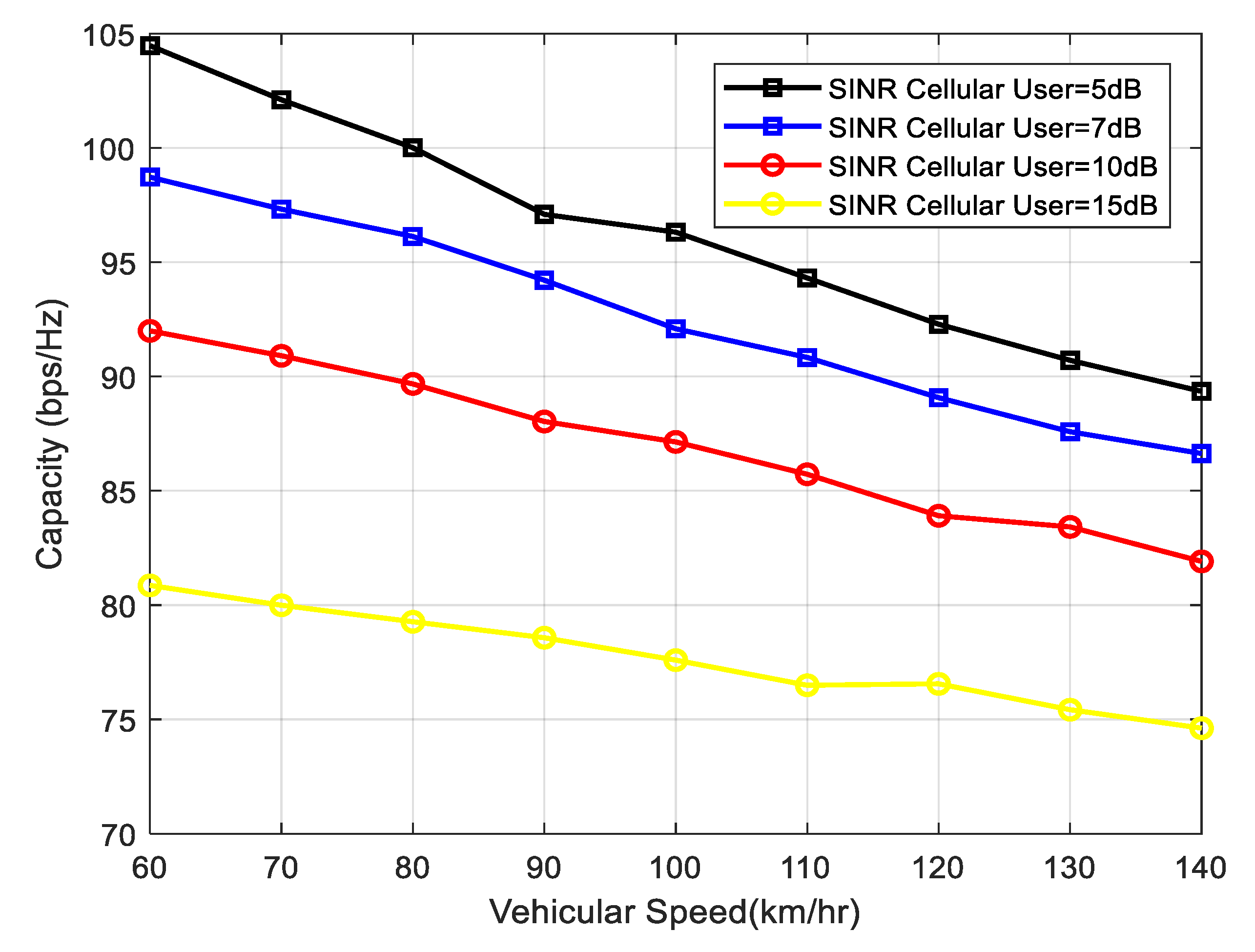
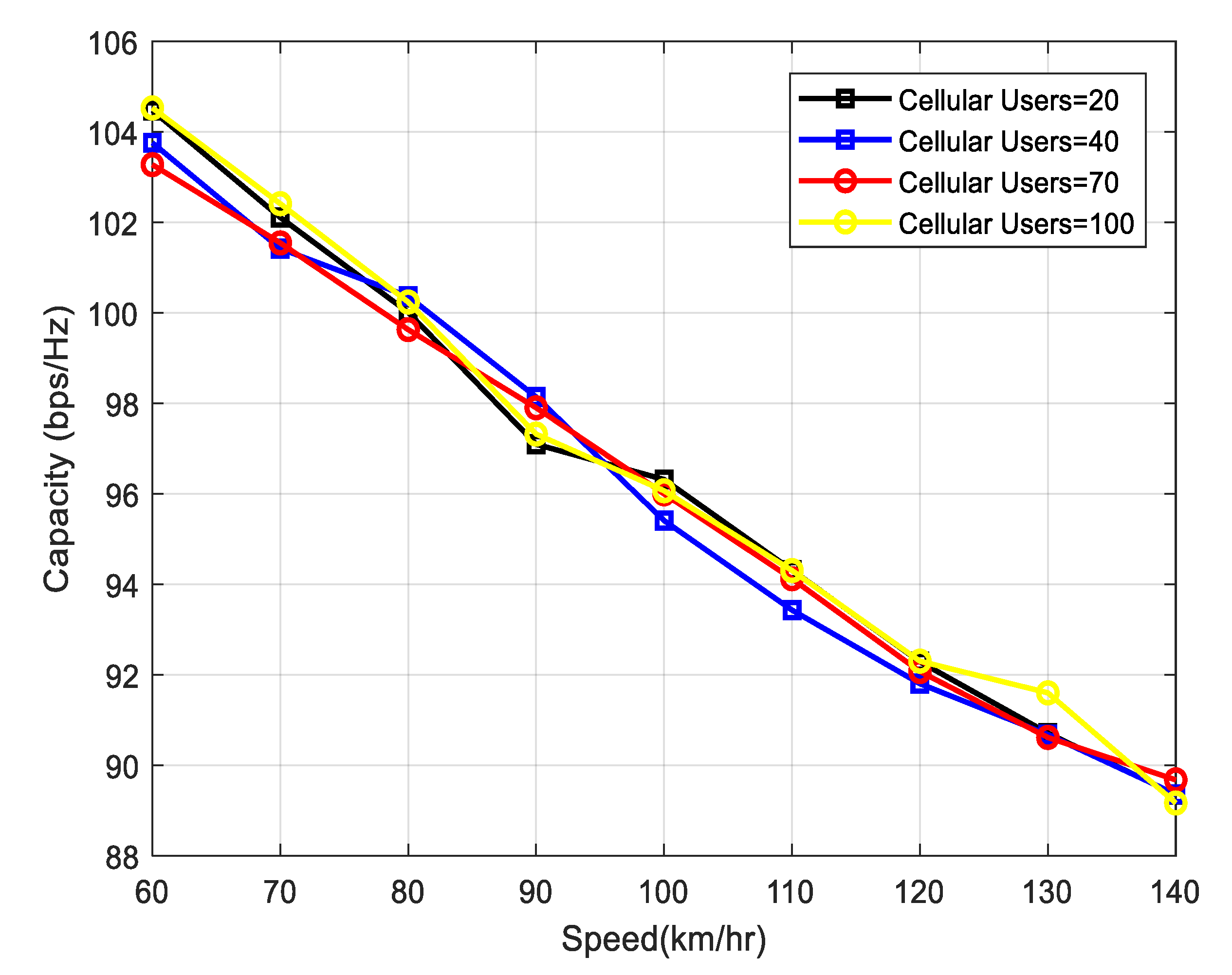


| V2V (ℓ) | V2I(k) | CUE(j) |
|---|---|---|
| High reliability (probability of outage under a certain threshold) | Large capacity | Best effort (minimum SINR guaranteed) |
| Pr {γl ≤ γ0} ≤ p0 | Maximize |
| Symbol. | Definition |
|---|---|
| Desired channel gain for CUE | |
| Desired channel gain for V2I | |
| Desired channel gain for V2V | |
| Interference channel gain from V2I to CUE | |
| Interference channel gain from V2V to CUE | |
| Interference channel gain from CUE to V2I | |
| Interference channel gain from V2V to V2I | |
| Interference channel gain from CUE to V2V | |
| Interference channel gain from V2I to V2V |
| Parameter | V2V Link | V2I Link | CUE Link |
|---|---|---|---|
| Path loss model | 127 + 30 log10(ℓ) | 128.1 + 37.6log10(ℓ) | 128.1 + 37.6log10(ℓ) |
| Independent Interferers | Cumulative Interferers | |
|---|---|---|
| Parameters | Value |
|---|---|
| Carrier frequency/bandwidth | 2 GHz/10 MHz |
| Number of RBs | 20 |
| Cell radius | 500 m |
| Vehicle speed (variable) | 60–140 km/h |
| Reliability for V2V p0 | 0.01 |
| Number of V2V Users(L) | 10,20,30,40,50 |
| Number of V2I Users(K) | 20 |
| Number of CUE Users(J) | 20,40,70,100 |
| Max. transmit power for all UEs | 14,17,20,23 dB |
| (threshold SINR for CUEs) | 5,6,10,15 dB |
| δJ, δK, δL | 20 dB |
| Tolerance for Newton method | Exp (−7) |
© 2019 by the authors. Licensee MDPI, Basel, Switzerland. This article is an open access article distributed under the terms and conditions of the Creative Commons Attribution (CC BY) license (http://creativecommons.org/licenses/by/4.0/).
Share and Cite
Khan, U.A.; Lee, S.S. Three-Dimensional Resource Allocation in D2D-Based V2V Communication. Electronics 2019, 8, 962. https://doi.org/10.3390/electronics8090962
Khan UA, Lee SS. Three-Dimensional Resource Allocation in D2D-Based V2V Communication. Electronics. 2019; 8(9):962. https://doi.org/10.3390/electronics8090962
Chicago/Turabian StyleKhan, Usman Ali, and Sang Sun Lee. 2019. "Three-Dimensional Resource Allocation in D2D-Based V2V Communication" Electronics 8, no. 9: 962. https://doi.org/10.3390/electronics8090962





